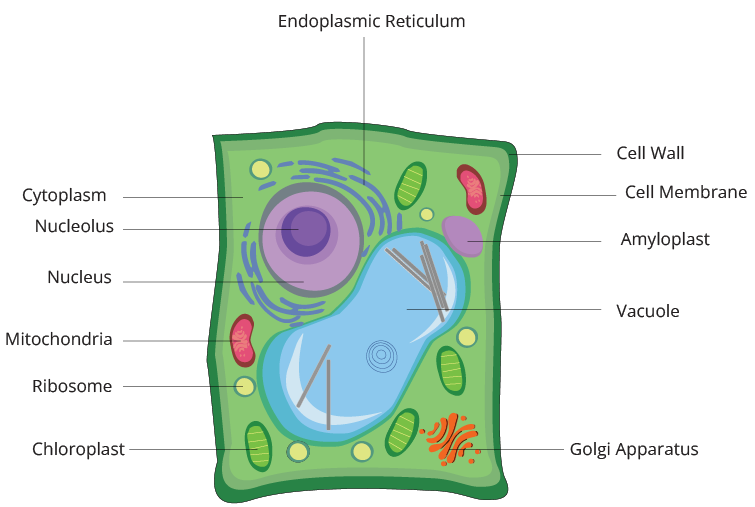Complete Solutions for Class 9 Science Chapter 5 - Learn with Expert Guidance
NCERT Solutions for Class 9 Science Chapter 5 - The Fundamental Unit of Life
FAQs on NCERT Solutions for Class 9 Science Chapter 5 - The Fundamental Unit of Life
1. How should one correctly solve the NCERT question that asks for a diagram of an animal cell and a plant cell?
To solve this question as per the CBSE 2025-26 guidelines, you must draw two separate, clearly labelled diagrams. For the animal cell, ensure you include the cell membrane, cytoplasm, nucleus, mitochondria, and lysosomes. For the plant cell, it is crucial to add the cell wall, a large central vacuole, and chloroplasts, in addition to the common organelles. Correctly labelling these distinct parts is key to securing full marks.
2. What is the correct method, as per the NCERT textbook, to explain the differences between prokaryotic and eukaryotic cells?
The correct method is to present the differences in a tabular format for clarity. Key points to include are:
- Size: Prokaryotic cells are generally small (1-10 µm), while eukaryotic cells are larger (5-100 µm).
- Nucleus: A well-defined nucleus is absent in prokaryotes (region is called a nucleoid), but present in eukaryotes.
- Chromosomes: Prokaryotes have a single chromosome, whereas eukaryotes have more than one.
- Organelles: Membrane-bound organelles like mitochondria and plastids are absent in prokaryotes but present in eukaryotes.
3. According to the NCERT Solutions, how do substances like CO2 and water move in and out of the cell?
The NCERT solutions explain two primary processes:
- Diffusion: Substances like Carbon Dioxide (CO2) move from an area of high concentration to an area of low concentration across the cell membrane. This happens when cellular waste CO2 builds up inside the cell and needs to be expelled.
- Osmosis: Water moves across a selectively permeable membrane from a region of high water concentration to one of low water concentration. This is a special case of diffusion and is crucial for maintaining the cell's water balance.
4. How does the NCERT solution for Class 9 Science explain why lysosomes are known as 'suicide bags' of the cell?
The solution explains that lysosomes contain powerful digestive enzymes capable of breaking down all organic material. When a cell gets damaged or old, the lysosome may burst, and its enzymes digest its own cell. Because this process of cellular self-destruction, or autolysis, leads to the cell's death, lysosomes are aptly called 'suicide bags'.
5. Why is the plasma membrane called a selectively permeable membrane in the NCERT solutions for Chapter 5?
The NCERT solutions emphasise this term because the plasma membrane does not allow all substances to pass through it freely. It actively regulates the movement of substances in and out of the cell. It permits the entry and exit of some materials while preventing the movement of others. This selectivity is vital for maintaining the cell's internal environment, distinct from its surroundings.
6. When solving NCERT problems, why is it incorrect to state that a plant cell placed in a hypotonic solution will burst?
This is incorrect because plant cells have a rigid cell wall outside the plasma membrane. When placed in a hypotonic solution, water enters the cell via osmosis, causing it to swell. However, the rigid cell wall exerts an equal pressure (turgor pressure) against the swollen cell, preventing it from bursting. Animal cells, which lack a cell wall, would burst under the same conditions.
7. What key points should be included when solving an NCERT question on the functions of the nucleus?
A comprehensive answer based on the NCERT solutions should highlight these three key functions:
- Cellular Reproduction: The nucleus plays a central role in cell division, the process by which a single cell divides into two new cells.
- Genetic Information: It contains chromosomes, which carry genes (segments of DNA) that hold the information necessary for constructing and organising cells.
- Control Centre: The nucleus directs all the chemical activities of the cell, effectively acting as its control centre or 'brain'.
8. The NCERT solutions describe chromosomes as being composed of DNA and protein. Why is this protein component crucial for the cell's function?
The protein component, primarily histones, is crucial for packaging and structure. The long DNA molecule in a eukaryotic cell is extremely long and must fit inside the tiny nucleus. Histone proteins act like spools around which the DNA winds, allowing it to be condensed into a compact structure called chromatin. This not only saves space but also plays a key role in regulating which genes are 'turned on' or 'off'.




















 Watch Video
Watch Video


















